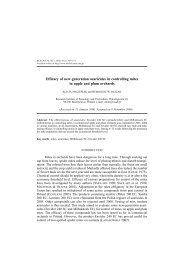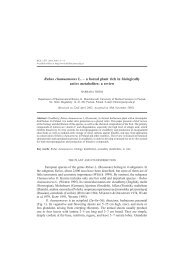The possible hybrid origin of the feather mite Avenzoaria canuti ...
The possible hybrid origin of the feather mite Avenzoaria canuti ...
The possible hybrid origin of the feather mite Avenzoaria canuti ...
Create successful ePaper yourself
Turn your PDF publications into a flip-book with our unique Google optimized e-Paper software.
128 Agnieszka Badek and Jacek Dabert<br />
REFERENCES<br />
ACKERMANN R. R., CHEVERUD J. M. 2002. Discerning evolutionary processes in patterns <strong>of</strong> Tamarin<br />
(genus Saguinus) crani<strong>of</strong>acial variation. Am. J. Phys. Antropol. 117: 260–271.<br />
BADEK A. 2004. Taxonomic status <strong>of</strong> oligoxenic fea<strong>the</strong>r <strong>mite</strong> species <strong>Avenzoaria</strong> totani Canestrini,<br />
1878 and A. calidridis Oudemans, 1905 (Astigmata, Analgoidea, Avenzoariidae). Unpubl. MSc<br />
<strong>the</strong>sis, Faculty <strong>of</strong> Biology, A. Mickiewicz University, Poznañ (in Polish).<br />
BADEK A., DABERT J. 2005. A new species <strong>of</strong> <strong>the</strong> genus <strong>Avenzoaria</strong> Oudemans, 1905 (Acari:<br />
Avenzoariidae) from <strong>the</strong> red knot, Calidris canutus (L.) (Aves, Charadriiformes). Entomol.<br />
Mitt. zool. Mus. Hamburg 14: 237–243.<br />
DABERT J. 1991. Fea<strong>the</strong>r <strong>mite</strong>s (Astigmata; Analgoidea, Freyanoidea, Pterolichoidea) <strong>of</strong> <strong>the</strong> waders<br />
(Charadrii, Scolopaci) from Poland. Unpubl. PhD <strong>the</strong>sis, Faculty <strong>of</strong> Biology, A. Mickiewicz<br />
University, Poznañ (in Polish).<br />
DABERT J. 2005. Fea<strong>the</strong>r <strong>mite</strong>s (Astigmata; Pterolichoidea, Analgoidea) and birds as models for<br />
cophylogenetic studies. Phytophaga 14: 409–424.<br />
DABERT J., DABERT M., MIRONOV S. V. 2001. Phylogeny <strong>of</strong> fea<strong>the</strong>r <strong>mite</strong> subfamily Avenzoariinae<br />
(Acari: Analgoidea: Avenzoariidae) inferred from combined analyses <strong>of</strong> molecular and morphological<br />
data. Mol. Phyl. Evol. 20: 124–135.<br />
DABERT J., MIRONOV S. V. 1999. Origin and evolution <strong>of</strong> fea<strong>the</strong>r <strong>mite</strong>s (Astigmata). Exp. Appl.<br />
Acarol. 23: 437–454.<br />
DABERT M., SOLARCZYK P., BADEK A., DABERT J. 2005. Taxonomic status <strong>of</strong> <strong>the</strong> oligoxenous fea<strong>the</strong>r<br />
<strong>mite</strong> species: are we dealing with species in statu nascendi? Phytophaga 14: 425–431.<br />
DIAS L. A. S., PICOLI E. A. T., ROCHA R. B., ALFENAS A. C. 2004. A priori choice <strong>of</strong> <strong>hybrid</strong> parents<br />
in plants. Genet. Mol. Res. 3: 356–368.<br />
EVANS G. O. 1992. Principles <strong>of</strong> Acarology. CAB International, Wallingford, UK.<br />
GAUD J., ATYEO W. T. 1996. Fea<strong>the</strong>r <strong>mite</strong>s <strong>of</strong> <strong>the</strong> world (Acarina, Astigmata): <strong>The</strong> supraspecific<br />
taxa. Part 1 Text. Ann. Mus. Roy. Afr. Centr. Ser. in 8. Sci. Zool. 277: 1–193.<br />
HARVATI K., FROST S. R., MCNULTY K. P. 2004. Neanderthal taxonomy reconsidered: Implications<br />
<strong>of</strong> 3d primate models <strong>of</strong> intra- and interspecific differences. Proc. Natl. Acad. Sci. USA 101:<br />
1147– 1152.<br />
MARROIG G., CHEVERUD J. M. 2001. A comparison <strong>of</strong> phenotypic variation and covariation patterns<br />
and <strong>the</strong> role <strong>of</strong> phylogeny, ecology, and ontogeny during cranial evolution <strong>of</strong> new world<br />
monkeys. Evolution 55: 2576– 2600.<br />
PAGE R. D. M. 2001. TreeView 1.6.6. Program distributed by <strong>the</strong> author, Institute <strong>of</strong> Biomedical<br />
and Life Sciences, University <strong>of</strong> Glasgow, Glasgow.<br />
PROCTOR H. C. 2003. Fea<strong>the</strong>r <strong>mite</strong>s (Acari: Astigmata): Ecology, behavior, and evolution. Annu.<br />
Rev. Entomol. 48: 185–209.<br />
SWOFFORD D. L. 2002. PAUP*. Phylogenetic Analysis Using Parsimony (*and O<strong>the</strong>r Methods).<br />
Version 4b10. Sinauer Associates, Sunderland, Massachusetts.<br />
Associate editor: ANNA SKORACKA





